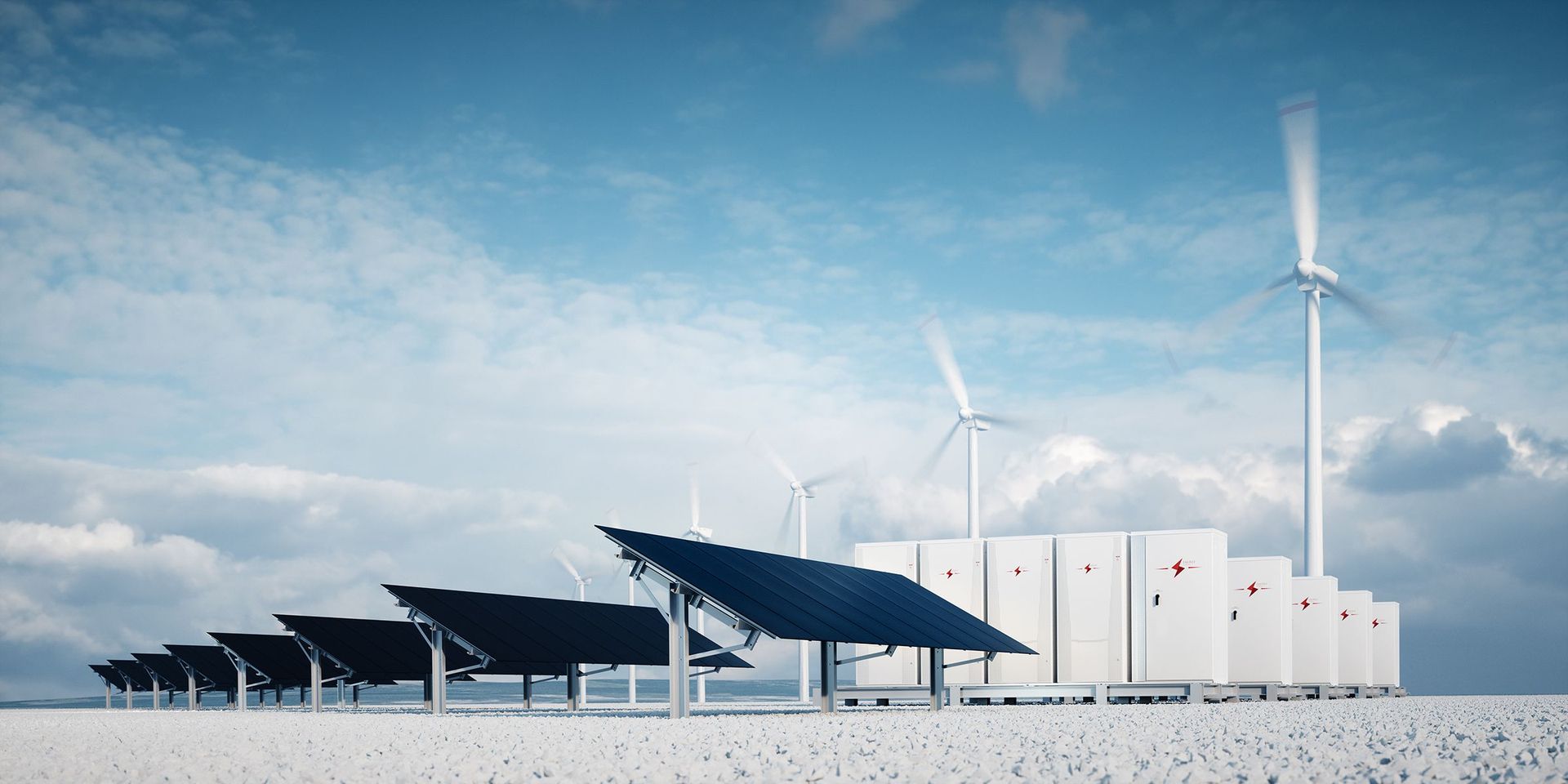Bulk Loss Risk: How Conventional Power Plants Endanger Security of Supply
The opinion persists that too many renewable energies in the energy mix would endanger the security of supply. Although there are currently still challenges that renewables cannot (yet) solve entirely on their own – keyword dark doldrums – the trend of the last few years shows that the security of supply in Germany has not declined, despite an increasing share of distributed renewable and volatile electricity producers. On the contrary, it has even increased. The Federal Network Agency publishes the SAIDI, which is the System Average Interruption Duration Index that documents the energy supply disruptions of a year and in which the cause of these disruptions is also identified – showing the increase in security of supply despite a simultaneous increase in renewable energies.
Table of Contents

Rarely in the headlines, however, is another risk to security of supply, which is caused by too high a proportion of conventional power plants: the so-called bulk loss risk of conventional power plants. You have never heard of it? Hardly surprising, because in Germany, the bulk loss risk in the energy system is now very low thanks to the relatively high share of renewables.
What Exactly Does Bulk Loss Risk Mean?
Bulk loss risk is the accumulation of failure risks. The risk is not diversified. The term originates from the banking industry and is also referred to as concentration risk. A bulk loss risk arises when there are too many correlations in the asset portfolio, or, for example, when just one customer receives a huge credit line. If this customer is unable to pay, the lender himself is in danger of going bankrupt. In contrast, a simultaneous failure of many small borrowers is rather unlikely, i.e. the risk is lower. In order to avoid bulk risk loss, you need to diversify your portfolio and thus spread the risk.
When applied to the energy system, bulk loss risk always occurs when the system is too dependent on a few components, such as individual plants or players. Large conventional power plants bundle large capacities in one asset at one location, and usually only a few companies own them. If an outage occurs, this has far-reaching consequences for security of supply.
In the case of renewable energies, especially wind and photovoltaics, the technical properties of the plants alone spread the risk. The individual plants are usually smaller, more numerous and distributed decentrally. The risk of outage is spread over so many shoulders that it continues to decrease.
In Germany, the security of supply is quite high, and that partly stems from renewables. The situation is different for our neighbors in the west, though: In Belgium and France, there are many reports that security of supply is threatened. The reason is that the electricity systems are largely based on large conventional infrastructure - nuclear power plants - which show an increase in – sometimes sudden – outages as they get older.
While the feed-in of wind and PV is subject to fluctuations, constantly improving forecasts can predict and thus help balance out these fluctuations more effectively. Corresponding forecasts for the failure or breakdown of conventional power plants or delays in maintenance and repair work on the nuclear reactors do not exist. They are usually not so easy to predict, happen suddenly and when they do happen, large amounts of capacity are missing in one fell swoop for a long time. Such sudden outages of large power plants destabilize the entire European interconnected grid.
The example of Belgium illustrates this problem more clearly.
Belgium: Many Conventional Power Plants and Little Security of Supply?
Just 70 kilometres from the German city of Aachen is the aging Tihange nuclear power plant. Time and again, the nuclear reactor has to be shut down and maintained. And the Doel nuclear power plant also crumbles. For several weeks of 2018, only one of the seven Belgian nuclear reactors was in operation. The situation was so desolate that the grid operator Elia warned that especially in consumption-intensive months such as November, security of supply would no longer be guaranteed without additional capacities.
After all, Tihange and Doel generate 50 percent of the electricity in Belgium. The website of the International Atomic Energy Agency (IAEA) provides a good overview of the increase in outages.
But is Belgium seriously threatened by blackouts? Because, despite the existing risks, it has not yet happened. Let's take a look and think this through. What would be the political and market consequences of the bulk loss risk if all the blocks went off the grid at the same time?
Market Consequences of Bulk Loss Risk
If all reactors were to be out of order, there would be an electricity shortage in Belgium. This would result in a sharp rise in prices on the market. Particularly problematic is this for smaller players in the electricity system, who are less equipped to manage and compensate for strong fluctuations. Strong price fluctuations mean stress on the system, which not all participants will be able to cope with.
At the same time, higher prices would also provide greater incentives for expanding capacities. Thus, the dynamic on the market could accelerate the expansion of renewables. The problem would minimize bulk risk loss in the longer term through self-induced investment signals.
Political Consequences of Clustering Risk
The bulk loss risk in Belgium exists and it is a risk that must be taken seriously and that requires action.
It is simply a fact that the electricity system in Belgium is dependent on only a few large power plants and players, which therefore have great market power.
Restructuring the system towards more players should be gradual and not, as is currently planned, with all the nuclear reactors shut down in very short succession. The discussed nuclear phase-out in 2025 also brings with it a discussion if a capacity market is reasonable and needed. It is a heated debate, and supporters of the capacity market are grooming the threat of a blackout.
Whether a capacity market is necessary or not is usually a fundamental debate, which is all the more difficult because there is no such thing as the one capacity market design. We at Next Kraftwerke are convinced that introducing a capacity market is not necessary – even in post nuclear phase-out Belgium - due to existing flexible capacities, such as balancing energy, the intraday market, the harmonization of the European electricity market, and the increasing coordination of electricity consumption and production. In addition, a capacity market is very expensive and generally benefits large and conventional power plants, so the bulk risk loss is increased rather than reduced.
Let’s dive into some more detail on current strategies in Belgium that are designed to minimize bulk loss risk and post alternatives to the capacity market from 2025 onwards.
Read more
Belgium: How to Currently Minimize the Bulk Loss Risk?
As a consequence of the bulk loss risk, electricity trading with neighboring countries should and will be intensified in the future – that includes trading with Germany. With the construction of the ALEGrO cable (Aachen Liège Electricity Grid Overlay), a German-Belgian high-voltage line connecting the German province Northrhine Westphalia with Liège, will be completed in 2020. Previously, there was no direct connection from Germany to Belgium and the electricity had to be routed via the Netherlands, with associated transmission losses. This is an important step towards intensifying European electricity trading and conclusively the electricity grid.
There is also an emergency plan that regulates when, in which municipalities, and for how long the electricity is switched off in an emergency. For this purpose, Belgium has been divided into six tranches, each of which is to be disconnected from the grid for two to three hours to relieve the strain on the grid. Rail traffic and, in Wallonia, even motorway lighting would be affected. These measures are the last resort against a blackout.
Greater promotion of renewables and the expansion of capacities - gas-fired power plants are under discussion - are necessary to achieve the nuclear phase-out by 2025. Albert Moser, Professor of Energy Economics at the RWTH Aachen University, makes it clear that only if Belgium starts to create new capacities very quickly, the phase-out of nuclear plants is actually possible by 2025.
In addition, some voices in the debate hinted at the possibility that it was no coincidence that six of the seven nuclear power plant units were in repair simultaneously. Electrabel, which was to carry out the repairs to the power plant units, was highly criticized for planning errors and the delay in the repairs.
Guido Camps, former head of the energy regulator in Belgium, stresses that Electrabel, a subsidiary of the French Engie group, wanted to put pressure on the negotiations on the nuclear phase-out in Belgium by shutting down the plants at the same time. According to Cramps, the aim is to achieve longer operating times for the nuclear power plants in Belgium that have already been written off and are therefore particularly lucrative.
A further facet of the concentration risk of large conventional power plants becomes obvious: Those who rely on a few power plants operated by only a few companies become dependent on precisely these technologies and companies and can thus become the pawn in the power struggle surrounding the energy transition.
Eliminating Bulk Loss Risk by Revising the Market Design
The task of eliminating bulk loss risk is difficult because, as the example of Belgium shows, these bulks prevent their elimination themselves. By making energy supply dependent on a small number of actors, these actors have the power to torpedo a much-needed transformation of the energy system towards a higher share of renewable energy. However, this is necessary not only for reasons of security of supply, but also and especially for a successful energy transition.
However, there are possibilities to adapt the market design in Belgium, which should be implemented and put into focus before discussing a capacity market. These could, if implemented consistently, make introducing the expensive capacity market unnecessary. A study commissioned by the BMWi, which in its analysis of the European electricity market considers a strategic reserve rather than a capacity market to be sufficient for security of supply in Belgium, comes to a similar conclusion.
- Intraday market and XBID: Reorganizing the Intraday market could pose a remedy. So far, only hourly products are traded in Belgium. This makes it difficult to integrate renewables, which are more suitable for quarter-hourly products. Due to the high market concentration, the Belgian intraday market has low liquidity. Allowing bids from neighboring countries on the market could be a possible solution. Other European countries have already done so with XBID Market Coupling. A complete market coupling of the intraday market via XBID would limit the liquidity problem in the market.
- Differences between different generation plants: Not all generation plants are treated equally. Larger generation plants, usually above 25 MW, are called CIPUs in Belgium. These have different framework conditions, for example in the balancing energy market, and some markets are not even accessible for smaller non-CIPU plants, such as the aFRR market. However, Elia has started to gradually open the aFRR market for smaller generation plants as well. A new market design would pave the way for market integration of renewables, which can contribute to system stability by participating in the balancing energy markets.
These are only two proposals that would exploit existing potentials and optimize the Belgian electricity market. Further proposals for an improved market design in Belgium after the nuclear phase-out are listed here.
Some steps in the right direction have already been taken, other low-hanging fruit offer further potential to prepare the market in Belgium for the nuclear phase-out and thus spread the existing bulk risk loss. These should be implemented first before introducing a capacity market is even discussed.
More information and services



